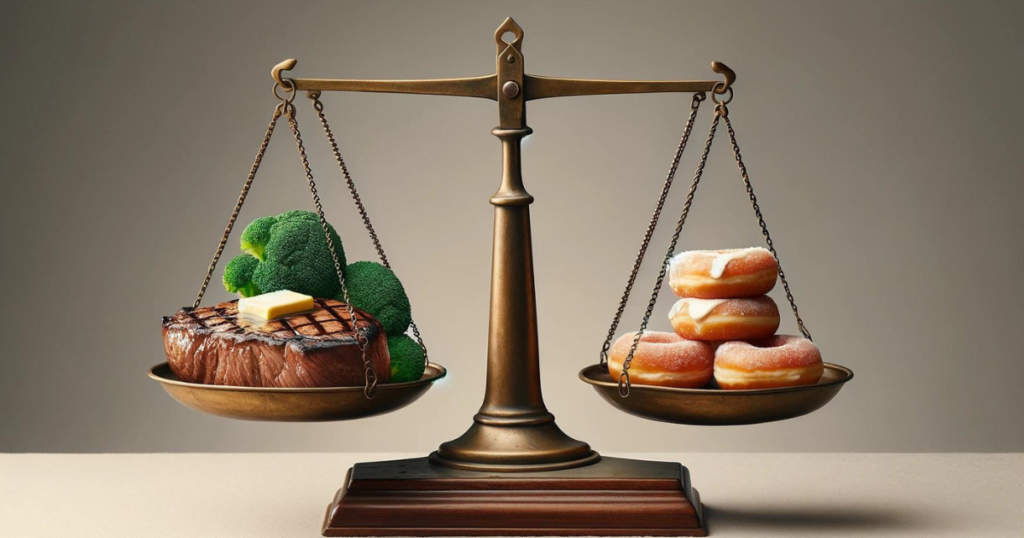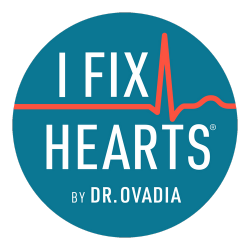I’m going to challenge a weight loss dogma that’s become firmly set in the American zeitgeist.
The idea of ‘eat less, lose more’ is a terrible approach to health.
If you’ve ever been overweight and visited a doctor, I’m sure you’ve heard the phrase once or twice.
I’m here to tell you it’s not only flawed reasoning, but it’s a pivotal part of our metabolic health crisis.
The flaws of trying to eat less
Hunger is one of the strongest survival instincts we have as humans.
Sure, you can try short-term fad diets, glucose shakes, or semaglutide injections.
But the fact is you’re still going to be hungry when you stop doing these things. You may even regain the weight you lost. And you’re probably going to feel miserable and unfulfilled the entire time you’re dieting.
I can’t tell you how many patients come to me after trying and failing to ‘eat less.’ I was there too — I was once a fat heart surgeon who couldn’t keep the weight off.
I did ‘all the right things’ to follow the proverb: I ate less and moved more. And with a rigorous diet and exercise regimen, I lost 50 pounds.
But it’s impossible to overcome hunger in the long term. And over time, the weight returned.
I was starting to believe that obesity was genetic and I was powerless to change my health.
But when my wife went gluten-free back in 2015, it sent me down a path of discovery.
I found that when you eat whole, real food — especially animal protein — you don’t have to focus on ‘eating less’ anymore. You’re simply not as hungry.
The only thing standing in my way was processed food, which has become extremely difficult to avoid over the last few decades.
The role of processed food
No diet is going to work if you can’t make it sustainable.
Which is why I’m a firm advocate of eating whole, real foods.
These are things our grandparents ate, like steak, eggs, and dairy products.
They’re not ‘near food objects’ like cheese-flavored crackers, soda, or cereal bars.
We know processed foods are mostly refined sugar and carbs, and contain unhealthy additives like seed oils and food dyes. More than 60% of the American diet comes from highly processed foods, and it’s no wonder why — nearly three in four items at the store are ultra-processed (and therefore, ultra-cheap).
We also know excessive sugars and carbohydrates lead to unhealthy spikes in blood sugar. Unless you’re an athlete or an extremely-active individual, excessive carb intake can lead to insulin resistance (and therefore insulin-induced hypoglycemia, which is hunger soon after eating).
Do you feel shaky or weak a few hours after eating? Or get intense cravings or hunger pangs after snacking on sweets? Your body’s trying to tell you it doesn’t have enough of the right fuel — and if you keep filling it with nutrient-devoid foods, you may find yourself eating every couple of hours.
I propose a simple solution to the endless ‘eat less’ hamster wheel.
Instead of reducing our overall food intake by counting calories and ‘burning’ excess, I suggest we reduce our processed food intake to lose weight naturally.
How to eat less without trying
The saying ‘we are what we eat’ is more powerful than we know.
Because starving ourselves to lose a few pounds or filling up on empty calories every few hours is a poor bet for sustained metabolic health.
That’s why I want you to start with a few simple principles:
- Only eat whole, real food. Toss out any ‘near food objects’ and consider cooking at home as often as you can. This ensures you’re eating nutritious meals while avoiding the endless hunger created by cheap, metabolically disastrous food.
- Make protein a staple of your diet. I recommend ruminant meat (like bison, venison, mutton, and beef) because of the B vitamins and trace minerals. Consuming more protein than the food pyramid recommends not only reduces body weight over time, but also helps to decrease body fat while increasing muscle growth.
- Reduce the amount of carbohydrates you consume and cut sugar from your diet (in whatever capacity this means to you). Remember: low-fat, high-carb foods can easily spike your blood sugar, causing you to feel hungrier sooner and leading to weight gain over time. I recommend using a continuous glucose monitor to keep track of spikes.
As you increase your intake of whole, real foods, you may find yourself going longer and longer without eating. It may be four to six hours until you’re ready for your next meal, and for some people, 12 to 16 hours or more.
That said, I don’t want you to be strict about dieting. No more watching the clock until dinner, and no feeling guilt if or when you need a snack. The important thing is to fuel your body with quality food and allow it to settle into a healthy routine.
If you’re feeding it whole, real food, it will tell you what you need to eat (and when).
This has been my experience for nearly a decade. Today, I get to eat what I want whenever I want while keeping the weight off.
And what I want is whole, real food a few times per day.
Additional strategies for healthy hunger
As your body becomes fat-adapted for burning ketones rather than glucose, you may consider additional strategies for maintaining and sustaining metabolic health.
First, intermittent fasting can do a world of good. Just make sure to eat enough during feeding windows.
You may also want to schedule benchmark blood panels so you can track progress over time. I recommend a few different types to continuously check your metabolic health.
And if your current doctor keeps recommending ‘eat less, move more,’ please consider switching physicians. I wrote a guide to firing your doctor so you can pursue the care you deserve.

